Unit 2 What time do you go to school? Section A Grammar focus 3a—3c 教案
文档属性
| 名称 | Unit 2 What time do you go to school? Section A Grammar focus 3a—3c 教案 |
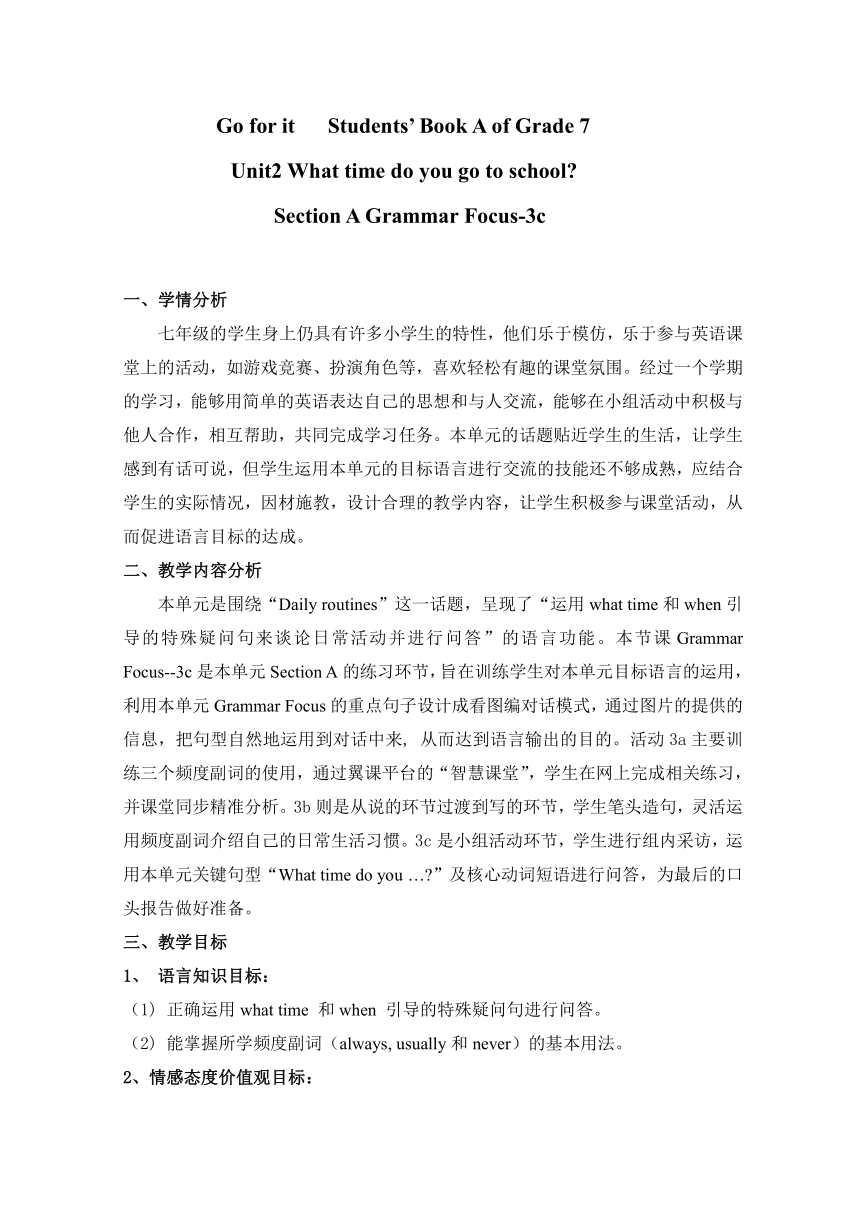
|
|
| 格式 | doc | ||
| 文件大小 | 20.1MB | ||
| 资源类型 | 教案 | ||
| 版本资源 | 人教新目标(Go for it)版 | ||
| 科目 | 英语 | ||
| 更新时间 | 2022-03-16 19:25:37 | ||
图片预览

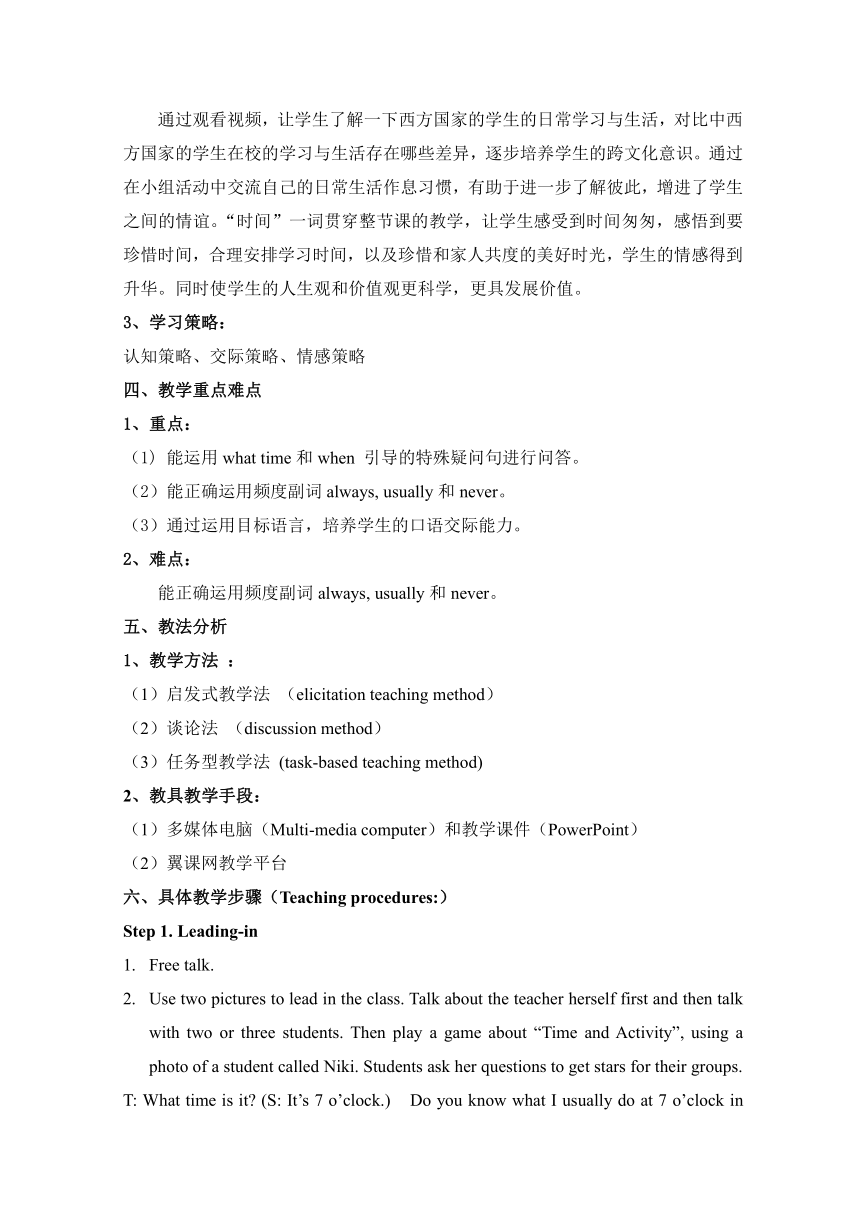
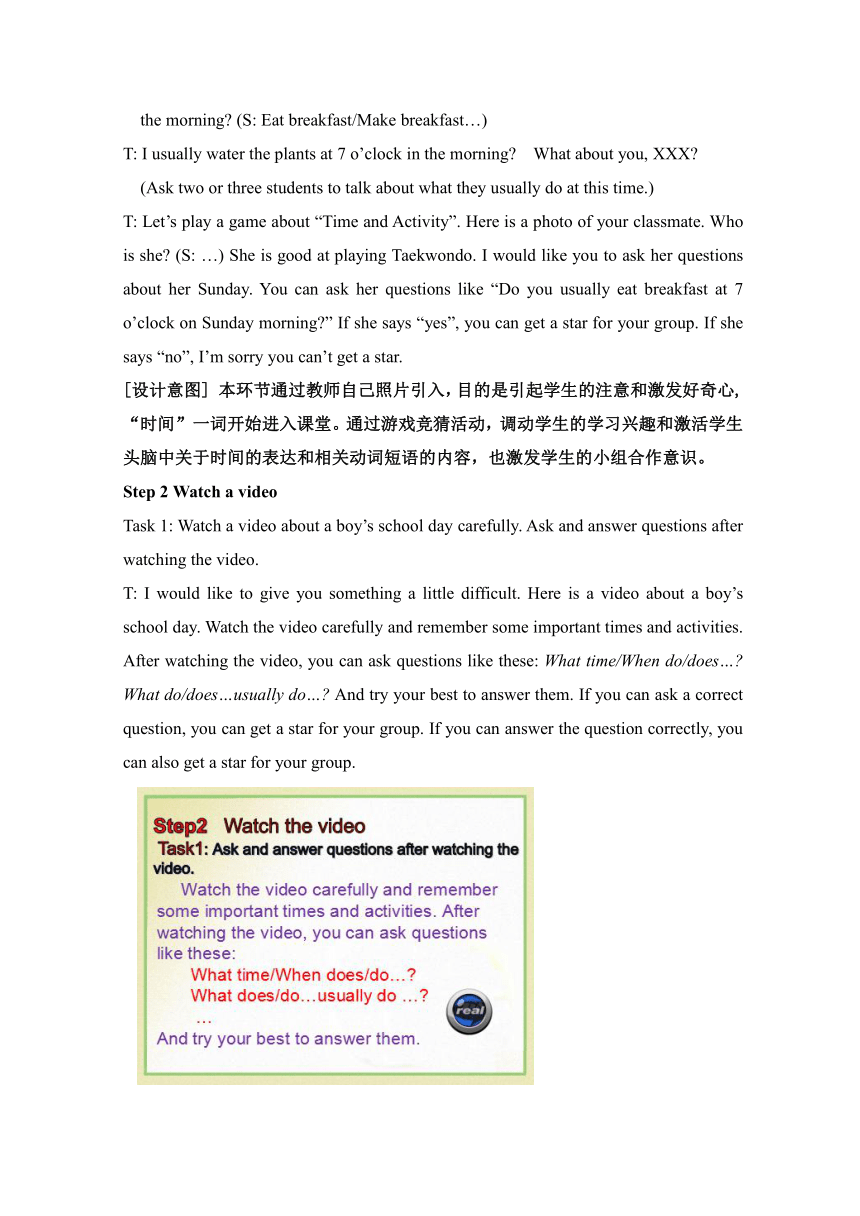
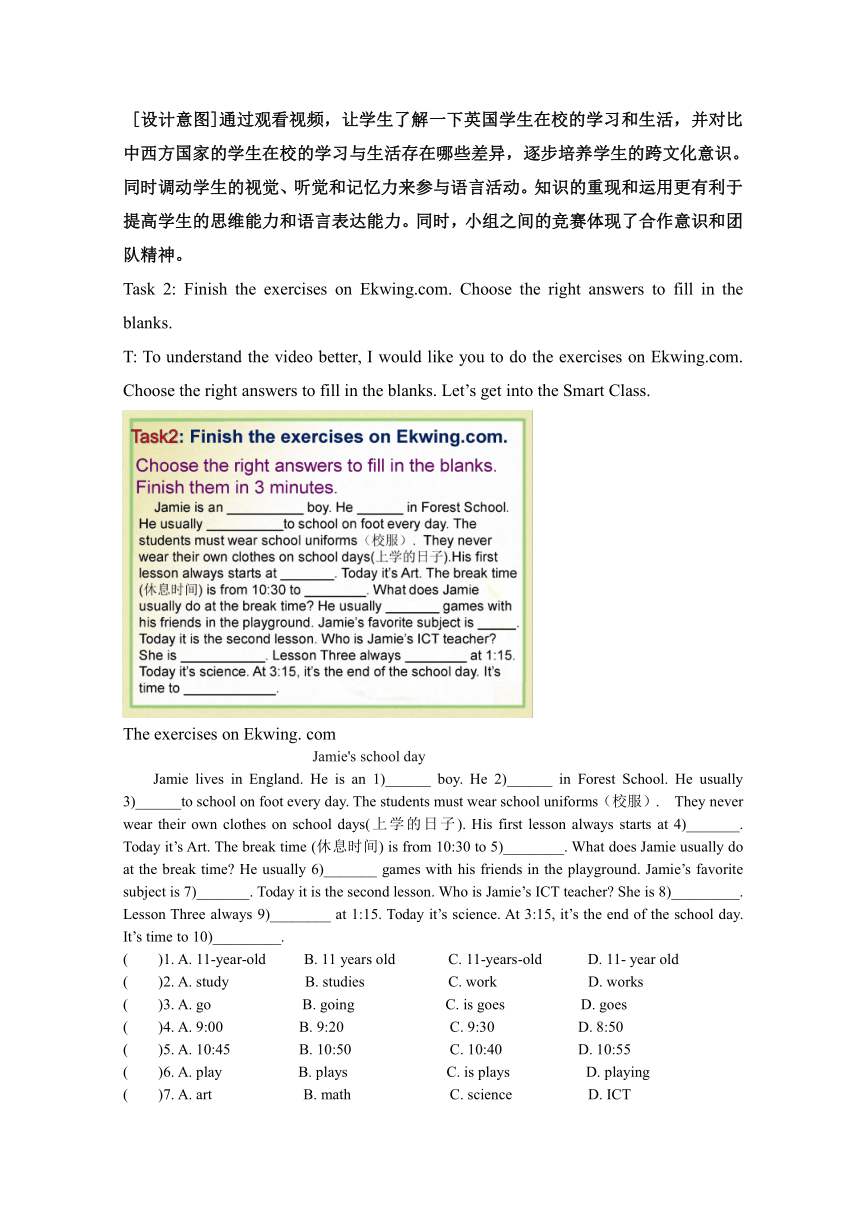
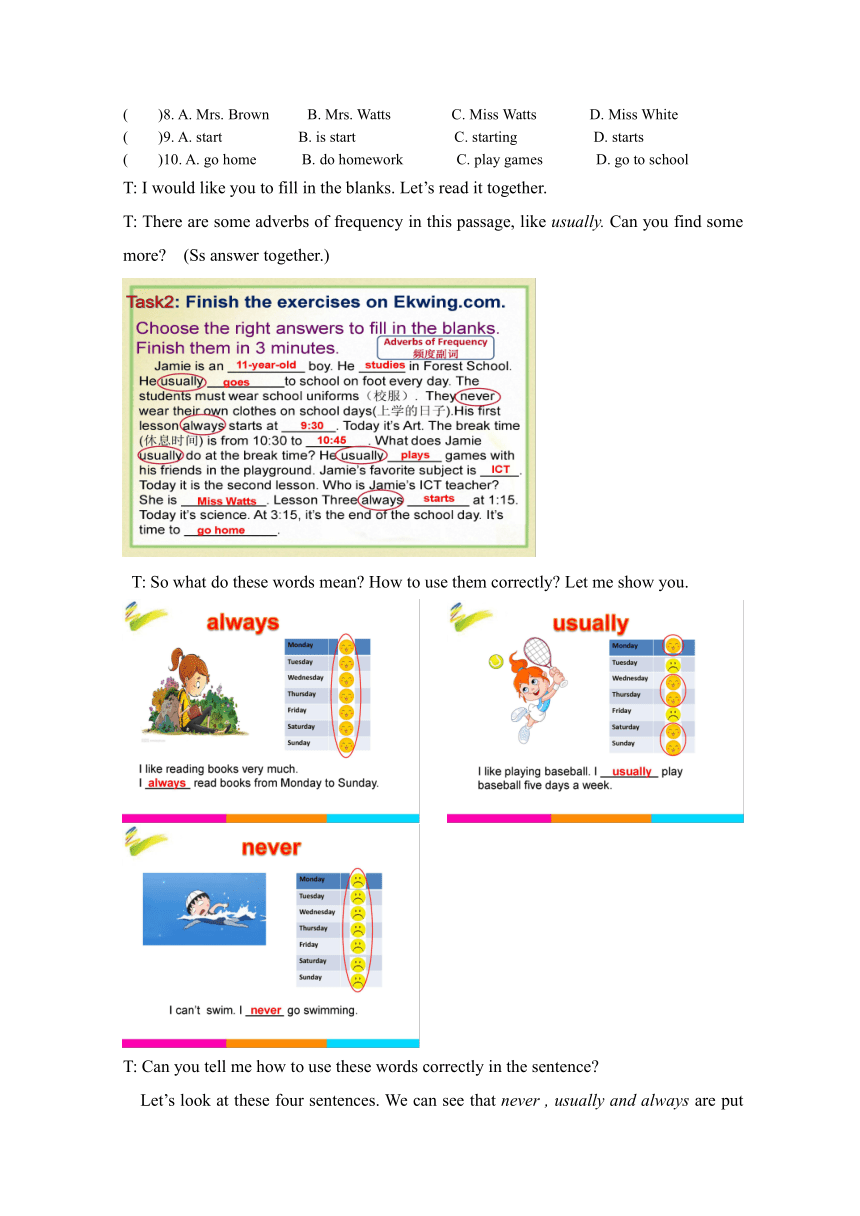
文档简介
Go for it Students’ Book A of Grade 7
Unit2 What time do you go to school
Section A Grammar Focus-3c
一、学情分析
七年级的学生身上仍具有许多小学生的特性,他们乐于模仿,乐于参与英语课堂上的活动,如游戏竞赛、扮演角色等,喜欢轻松有趣的课堂氛围。经过一个学期的学习,能够用简单的英语表达自己的思想和与人交流,能够在小组活动中积极与他人合作,相互帮助,共同完成学习任务。本单元的话题贴近学生的生活,让学生感到有话可说,但学生运用本单元的目标语言进行交流的技能还不够成熟,应结合学生的实际情况,因材施教,设计合理的教学内容,让学生积极参与课堂活动,从而促进语言目标的达成。
二、教学内容分析
本单元是围绕“Daily routines”这一话题,呈现了“运用what time和when引导的特殊疑问句来谈论日常活动并进行问答”的语言功能。本节课Grammar Focus--3c是本单元Section A的练习环节,旨在训练学生对本单元目标语言的运用,利用本单元Grammar Focus的重点句子设计成看图编对话模式,通过图片的提供的信息,把句型自然地运用到对话中来, 从而达到语言输出的目的。活动3a主要训练三个频度副词的使用,通过翼课平台的“智慧课堂”,学生在网上完成相关练习,并课堂同步精准分析。3b则是从说的环节过渡到写的环节,学生笔头造句,灵活运用频度副词介绍自己的日常生活习惯。3c是小组活动环节,学生进行组内采访,运用本单元关键句型“What time do you … ”及核心动词短语进行问答,为最后的口头报告做好准备。
三、教学目标
1、 语言知识目标:
(1) 正确运用what time 和when 引导的特殊疑问句进行问答。
(2) 能掌握所学频度副词(always, usually和never)的基本用法。
2、情感态度价值观目标:
通过观看视频,让学生了解一下西方国家的学生的日常学习与生活,对比中西方国家的学生在校的学习与生活存在哪些差异,逐步培养学生的跨文化意识。通过在小组活动中交流自己的日常生活作息习惯,有助于进一步了解彼此,增进了学生之间的情谊。“时间”一词贯穿整节课的教学,让学生感受到时间匆匆,感悟到要珍惜时间,合理安排学习时间,以及珍惜和家人共度的美好时光,学生的情感得到升华。同时使学生的人生观和价值观更科学,更具发展价值。
3、学习策略:
认知策略、交际策略、情感策略
四、教学重点难点
1、重点:
(1) 能运用what time和when 引导的特殊疑问句进行问答。
(2)能正确运用频度副词always, usually和never。
(3)通过运用目标语言,培养学生的口语交际能力。
2、难点:
能正确运用频度副词always, usually和never。
五、教法分析
1、教学方法 :
(1)启发式教学法 (elicitation teaching method)
(2)谈论法 (discussion method)
(3)任务型教学法 (task-based teaching method)
2、教具教学手段:
(1)多媒体电脑(Multi-media computer)和教学课件(PowerPoint)
(2)翼课网教学平台
六、具体教学步骤(Teaching procedures:)
Step 1. Leading-in
Free talk.
Use two pictures to lead in the class. Talk about the teacher herself first and then talk with two or three students. Then play a game about “Time and Activity”, using a photo of a student called Niki. Students ask her questions to get stars for their groups.
T: What time is it (S: It’s 7 o’clock.) Do you know what I usually do at 7 o’clock in the morning (S: Eat breakfast/Make breakfast…)
T: I usually water the plants at 7 o’clock in the morning What about you, XXX
(Ask two or three students to talk about what they usually do at this time.)
T: Let’s play a game about “Time and Activity”. Here is a photo of your classmate. Who is she (S: …) She is good at playing Taekwondo. I would like you to ask her questions about her Sunday. You can ask her questions like “Do you usually eat breakfast at 7 o’clock on Sunday morning ” If she says “yes”, you can get a star for your group. If she says “no”, I’m sorry you can’t get a star.
[设计意图] 本环节通过教师自己照片引入,目的是引起学生的注意和激发好奇心,
“时间”一词开始进入课堂。通过游戏竞猜活动,调动学生的学习兴趣和激活学生
头脑中关于时间的表达和相关动词短语的内容,也激发学生的小组合作意识。
Step 2 Watch a video
Task 1: Watch a video about a boy’s school day carefully. Ask and answer questions after watching the video.
T: I would like to give you something a little difficult. Here is a video about a boy’s school day. Watch the video carefully and remember some important times and activities. After watching the video, you can ask questions like these: What time/When do/does… What do/does…usually do… And try your best to answer them. If you can ask a correct question, you can get a star for your group. If you can answer the question correctly, you can also get a star for your group.
[设计意图]通过观看视频,让学生了解一下英国学生在校的学习和生活,并对比中西方国家的学生在校的学习与生活存在哪些差异,逐步培养学生的跨文化意识。同时调动学生的视觉、听觉和记忆力来参与语言活动。知识的重现和运用更有利于提高学生的思维能力和语言表达能力。同时,小组之间的竞赛体现了合作意识和团队精神。
Task 2: Finish the exercises on . Choose the right answers to fill in the blanks.
T: To understand the video better, I would like you to do the exercises on . Choose the right answers to fill in the blanks. Let’s get into the Smart Class.
The exercises on
Jamie's school day
Jamie lives in England. He is an 1)______ boy. He 2)______ in Forest School. He usually 3)______to school on foot every day. The students must wear school uniforms(校服). They never wear their own clothes on school days(上学的日子). His first lesson always starts at 4)_______. Today it’s Art. The break time (休息时间) is from 10:30 to 5)________. What does Jamie usually do at the break time He usually 6)_______ games with his friends in the playground. Jamie’s favorite subject is 7)_______. Today it is the second lesson. Who is Jamie’s ICT teacher She is 8)_________. Lesson Three always 9)________ at 1:15. Today it’s science. At 3:15, it’s the end of the school day. It’s time to 10)_________.
( )1. A. 11-year-old B. 11 years old C. 11-years-old D. 11- year old
( )2. A. study B. studies C. work D. works
( )3. A. go B. going C. is goes D. goes
( )4. A. 9:00 B. 9:20 C. 9:30 D. 8:50
( )5. A. 10:45 B. 10:50 C. 10:40 D. 10:55
( )6. A. play B. plays C. is plays D. playing
( )7. A. art B. math C. science D. ICT
( )8. A. Mrs. Brown B. Mrs. Watts C. Miss Watts D. Miss White
( )9. A. start B. is start C. starting D. starts
( )10. A. go home B. do homework C. play games D. go to school
T: I would like you to fill in the blanks. Let’s read it together.
T: There are some adverbs of frequency in this passage, like usually. Can you find some more (Ss answer together.)
T: So what do these words mean How to use them correctly Let me show you.
T: Can you tell me how to use these words correctly in the sentence
Let’s look at these four sentences. We can see that never , usually and always are put between the subject and the predicate verb.
T: There is another sentence. (I am never late for school.) We can see that never is after am. So pay attention to this: Adverbs of frequency should be put after be verbs, model verbs and auxiliary verbs.
[设计意图]学生利用从视频获取的信息来完成翼课网平台“智慧课堂”的相关练习,根据课堂同步数据的精准分析,有针对性地对一些题目进行释疑解难,达到精准教学的效果。借助图片讲解频度副词更直观,也易于学生理解掌握,同时引导学生观察句子中频度副词的位置,启发学生思维,让不同层次的学生更有效地掌握语言点。这一环节的设计是对本节课这三个频度副词的意义和用法进行难点突破。
Step 3 Pair work
Let students work in pair and make a short dialogue by using the following pictures. And then in the last dialogue, lead students to think about the usage and the differences of what time and when.
T: Here are some pictures. I’d like you to make a short dialogue by using the following pictures. If you can make a good short dialogue, I will give you one star for your group.
(Ss work in pair and make a dialogue.)
T: When do you friends exercise They usually exercise on weekends. We use when to ask a question. Can we use what time here (Ss answer.)
T: We can’t use what time here. So can you tell me how to use what time and when correctly (One student answers.)
[设计意图]利用图片把Grammar Focus的重点句子设计成对话模式,让学生运用重点句型进行简短的对话。图片能激发学生的思维,从而把图片信息和所学的句型联系起来,有利于学生更好地掌握目标语言。利用最后一组图片的句子引导学生思考what time和when的用法,帮助学生重新梳理所学知识,自然而然地落实本节课的教学重点。
Step 4 Do exercises
Let students finish the exercises in 3a on . Choose the right answers and finish them in 3 minutes.
T: I would like you to do some more exercises on . Please do the exercises in 3a. Let’s get in the Smart Class.
The exercises in 3a on
---What time do you get up on school days
---_____________________________
I always get up at 6 o’clock on school days.
I get up always at 6 o'clock on school days.
I get up at 6 o'clock on school days always.
I always gets up at 6 o'clock on school days.
---____________________________
---Rick always gets up at 6:20.
What time do Rick always get up
What time does Rick always gets up
What time does Rick always get up
What time always does Rick get up
---What time do you have breakfast
---___________________________
I usually have breakfast at 7:00.
I usually make breakfast at 7:20.
I don't have breakfast.
I have breakfast at home.
---_____________________________
---Anna never eats breakfast.
What does Anna do
Does Anna eat breakfast
What time does Anna usually eat breakfast
What time do Anna usually eats breakfast
---What time does your best(最好的) friend go to school
---_____________________________________
She usually go to school at 7:30.
She goes to school usually at 7:30.
She always goes to school at 7:30.
She goes to school on school days.
[设计意图]针对学生可能会出现的错误重新设计此题,把一般现在时的第三人称单数动词的形式、重点句型和频度副词在句中的位置三者结合起来,充分调动学生的思维能力,有利于学生更好落实本节课的教学重点。利用翼课网平台的“智慧课堂”,导出学生答题的数据,对错误题目进行精准分析,助力于教师的课堂教学。
Step 5 Practice
Let students write about something they always do, something they usually do and something they never do. And then ask them to talk about themselves.
T: It is time to write something about yourselves. I would like you to write something by using always, usually and never. And then I will choose some of you to talk about yourselves. Please write down the sentences in 3b on page 9.
[设计意图]学生根据自己的实际情况,灵活运用三个频度副词进行笔头造句。并通过随机抽选号码,让学生分享自己的日常生活习惯,不仅活跃课堂气氛,而且培养学生的语言表达能力,让学生在轻松的环境中感受到课堂学习的趣味性。
Step 6 Group work
Let students interview three of the classmates in their group. Find out what time they do these activities. Then give a report to the class.
T: After talking about yourselves, I would like you to interview three of your classmates in your group. You can use What time do you usually … to ask questions. And write down the time in the chart. Please complete the chart and write down what time they do these activities. Stand up, please. Ask your classmates. Go!
T: Now I would like to ask some of you to make a report for us. You can begin like this: In our group, …usually gets up late on weekends. She/He gets up at…
[设计意图]小组进行交流,学生根据自己的真实情况开展活动,增进彼此的了解,也提高了语言运用的真实性。小组活动能充分发挥学生的合作探究能力,培养学生相互协作的习惯。口头报告同组同学的生活习惯的这一活动,让学生产生有意义的输出,并使语言的运用最终落实于篇章之中。
Step 7 Summary
1. Learn how to ask questions like What time/When do you … and how to answer questions correctly.
2. Learn how to use always, usually and never to make sentences and talk about ourselves.
3. Learn how to make dialogues by using the sentence pattern “What time/When do you …
Step 8 Homework
1. Write a passage according to your interview on . Please hand it in on time.
2. Talk about your family what time they do the activities on weekends with your partner.
[设计意图]要求学生利用采访得来的信息写一份“采访报告”,从口头输出过渡到笔头输出,让学生在写作上得到训练,进一步锻炼学生的写作思维能力。而学生的交流由个人到家庭,不仅能更熟练地运用目标语言,而且还提高学生的语言交际能力,这也是对课堂教学的延伸,让学生学以致用。
教学反思
本节课在教学过程中较好地贯彻了“教师主导—学生主体”的教学结构思想。在教学的整个过程中,充分发挥学生的主动性,并鼓励学生体现个性化。从学生参与课堂实践的积极性到完成教师布置的任务来看,教学效果比较理想。有以下4大特点:
通过课前游戏、看视频作问答、对话竞赛等活动,提高了学生参与课堂活动的积极性,也培养了学生的小组协作意识。既调动了课堂的气氛,也让学生在参与的过程中逐步掌握以至熟练地运用目标语言进行交际活动。
各个教学环节都能把time和activity有机结合起来,设计思路脉络清晰,铺垫到位,循序渐进,落实了本节课的教学重点;利用图片启发学生的思维,从词到句,逐层推进,从而突破本节课的教学难点。
“时间”一词作为主线贯穿整节课,由“时间”引入课堂,也由“时间”结束课堂,首尾呼应,情感教育渗透在课堂活动中,使学生的情感得到升华。
课堂引入翼课平台的“智慧课堂”,打破传统的教学模式,助力于教师的课堂教学,为课堂教学精准导航。
本节课也有一些不足之处,比如说,由于学生的英语水平不一样,在小组竞赛活动中,不敢表现自我,参与的积极性还不高。本节课在时间的安排上还需要更加严密紧凑些,最后的“采访报告”环节未能让更多的学生分享他们的采访所得。在今后的教学中,将努力改正不足,取长补短,争取设计出更精彩更实效的英语课堂。
Unit2 What time do you go to school
Section A Grammar Focus-3c
一、学情分析
七年级的学生身上仍具有许多小学生的特性,他们乐于模仿,乐于参与英语课堂上的活动,如游戏竞赛、扮演角色等,喜欢轻松有趣的课堂氛围。经过一个学期的学习,能够用简单的英语表达自己的思想和与人交流,能够在小组活动中积极与他人合作,相互帮助,共同完成学习任务。本单元的话题贴近学生的生活,让学生感到有话可说,但学生运用本单元的目标语言进行交流的技能还不够成熟,应结合学生的实际情况,因材施教,设计合理的教学内容,让学生积极参与课堂活动,从而促进语言目标的达成。
二、教学内容分析
本单元是围绕“Daily routines”这一话题,呈现了“运用what time和when引导的特殊疑问句来谈论日常活动并进行问答”的语言功能。本节课Grammar Focus--3c是本单元Section A的练习环节,旨在训练学生对本单元目标语言的运用,利用本单元Grammar Focus的重点句子设计成看图编对话模式,通过图片的提供的信息,把句型自然地运用到对话中来, 从而达到语言输出的目的。活动3a主要训练三个频度副词的使用,通过翼课平台的“智慧课堂”,学生在网上完成相关练习,并课堂同步精准分析。3b则是从说的环节过渡到写的环节,学生笔头造句,灵活运用频度副词介绍自己的日常生活习惯。3c是小组活动环节,学生进行组内采访,运用本单元关键句型“What time do you … ”及核心动词短语进行问答,为最后的口头报告做好准备。
三、教学目标
1、 语言知识目标:
(1) 正确运用what time 和when 引导的特殊疑问句进行问答。
(2) 能掌握所学频度副词(always, usually和never)的基本用法。
2、情感态度价值观目标:
通过观看视频,让学生了解一下西方国家的学生的日常学习与生活,对比中西方国家的学生在校的学习与生活存在哪些差异,逐步培养学生的跨文化意识。通过在小组活动中交流自己的日常生活作息习惯,有助于进一步了解彼此,增进了学生之间的情谊。“时间”一词贯穿整节课的教学,让学生感受到时间匆匆,感悟到要珍惜时间,合理安排学习时间,以及珍惜和家人共度的美好时光,学生的情感得到升华。同时使学生的人生观和价值观更科学,更具发展价值。
3、学习策略:
认知策略、交际策略、情感策略
四、教学重点难点
1、重点:
(1) 能运用what time和when 引导的特殊疑问句进行问答。
(2)能正确运用频度副词always, usually和never。
(3)通过运用目标语言,培养学生的口语交际能力。
2、难点:
能正确运用频度副词always, usually和never。
五、教法分析
1、教学方法 :
(1)启发式教学法 (elicitation teaching method)
(2)谈论法 (discussion method)
(3)任务型教学法 (task-based teaching method)
2、教具教学手段:
(1)多媒体电脑(Multi-media computer)和教学课件(PowerPoint)
(2)翼课网教学平台
六、具体教学步骤(Teaching procedures:)
Step 1. Leading-in
Free talk.
Use two pictures to lead in the class. Talk about the teacher herself first and then talk with two or three students. Then play a game about “Time and Activity”, using a photo of a student called Niki. Students ask her questions to get stars for their groups.
T: What time is it (S: It’s 7 o’clock.) Do you know what I usually do at 7 o’clock in the morning (S: Eat breakfast/Make breakfast…)
T: I usually water the plants at 7 o’clock in the morning What about you, XXX
(Ask two or three students to talk about what they usually do at this time.)
T: Let’s play a game about “Time and Activity”. Here is a photo of your classmate. Who is she (S: …) She is good at playing Taekwondo. I would like you to ask her questions about her Sunday. You can ask her questions like “Do you usually eat breakfast at 7 o’clock on Sunday morning ” If she says “yes”, you can get a star for your group. If she says “no”, I’m sorry you can’t get a star.
[设计意图] 本环节通过教师自己照片引入,目的是引起学生的注意和激发好奇心,
“时间”一词开始进入课堂。通过游戏竞猜活动,调动学生的学习兴趣和激活学生
头脑中关于时间的表达和相关动词短语的内容,也激发学生的小组合作意识。
Step 2 Watch a video
Task 1: Watch a video about a boy’s school day carefully. Ask and answer questions after watching the video.
T: I would like to give you something a little difficult. Here is a video about a boy’s school day. Watch the video carefully and remember some important times and activities. After watching the video, you can ask questions like these: What time/When do/does… What do/does…usually do… And try your best to answer them. If you can ask a correct question, you can get a star for your group. If you can answer the question correctly, you can also get a star for your group.
[设计意图]通过观看视频,让学生了解一下英国学生在校的学习和生活,并对比中西方国家的学生在校的学习与生活存在哪些差异,逐步培养学生的跨文化意识。同时调动学生的视觉、听觉和记忆力来参与语言活动。知识的重现和运用更有利于提高学生的思维能力和语言表达能力。同时,小组之间的竞赛体现了合作意识和团队精神。
Task 2: Finish the exercises on . Choose the right answers to fill in the blanks.
T: To understand the video better, I would like you to do the exercises on . Choose the right answers to fill in the blanks. Let’s get into the Smart Class.
The exercises on
Jamie's school day
Jamie lives in England. He is an 1)______ boy. He 2)______ in Forest School. He usually 3)______to school on foot every day. The students must wear school uniforms(校服). They never wear their own clothes on school days(上学的日子). His first lesson always starts at 4)_______. Today it’s Art. The break time (休息时间) is from 10:30 to 5)________. What does Jamie usually do at the break time He usually 6)_______ games with his friends in the playground. Jamie’s favorite subject is 7)_______. Today it is the second lesson. Who is Jamie’s ICT teacher She is 8)_________. Lesson Three always 9)________ at 1:15. Today it’s science. At 3:15, it’s the end of the school day. It’s time to 10)_________.
( )1. A. 11-year-old B. 11 years old C. 11-years-old D. 11- year old
( )2. A. study B. studies C. work D. works
( )3. A. go B. going C. is goes D. goes
( )4. A. 9:00 B. 9:20 C. 9:30 D. 8:50
( )5. A. 10:45 B. 10:50 C. 10:40 D. 10:55
( )6. A. play B. plays C. is plays D. playing
( )7. A. art B. math C. science D. ICT
( )8. A. Mrs. Brown B. Mrs. Watts C. Miss Watts D. Miss White
( )9. A. start B. is start C. starting D. starts
( )10. A. go home B. do homework C. play games D. go to school
T: I would like you to fill in the blanks. Let’s read it together.
T: There are some adverbs of frequency in this passage, like usually. Can you find some more (Ss answer together.)
T: So what do these words mean How to use them correctly Let me show you.
T: Can you tell me how to use these words correctly in the sentence
Let’s look at these four sentences. We can see that never , usually and always are put between the subject and the predicate verb.
T: There is another sentence. (I am never late for school.) We can see that never is after am. So pay attention to this: Adverbs of frequency should be put after be verbs, model verbs and auxiliary verbs.
[设计意图]学生利用从视频获取的信息来完成翼课网平台“智慧课堂”的相关练习,根据课堂同步数据的精准分析,有针对性地对一些题目进行释疑解难,达到精准教学的效果。借助图片讲解频度副词更直观,也易于学生理解掌握,同时引导学生观察句子中频度副词的位置,启发学生思维,让不同层次的学生更有效地掌握语言点。这一环节的设计是对本节课这三个频度副词的意义和用法进行难点突破。
Step 3 Pair work
Let students work in pair and make a short dialogue by using the following pictures. And then in the last dialogue, lead students to think about the usage and the differences of what time and when.
T: Here are some pictures. I’d like you to make a short dialogue by using the following pictures. If you can make a good short dialogue, I will give you one star for your group.
(Ss work in pair and make a dialogue.)
T: When do you friends exercise They usually exercise on weekends. We use when to ask a question. Can we use what time here (Ss answer.)
T: We can’t use what time here. So can you tell me how to use what time and when correctly (One student answers.)
[设计意图]利用图片把Grammar Focus的重点句子设计成对话模式,让学生运用重点句型进行简短的对话。图片能激发学生的思维,从而把图片信息和所学的句型联系起来,有利于学生更好地掌握目标语言。利用最后一组图片的句子引导学生思考what time和when的用法,帮助学生重新梳理所学知识,自然而然地落实本节课的教学重点。
Step 4 Do exercises
Let students finish the exercises in 3a on . Choose the right answers and finish them in 3 minutes.
T: I would like you to do some more exercises on . Please do the exercises in 3a. Let’s get in the Smart Class.
The exercises in 3a on
---What time do you get up on school days
---_____________________________
I always get up at 6 o’clock on school days.
I get up always at 6 o'clock on school days.
I get up at 6 o'clock on school days always.
I always gets up at 6 o'clock on school days.
---____________________________
---Rick always gets up at 6:20.
What time do Rick always get up
What time does Rick always gets up
What time does Rick always get up
What time always does Rick get up
---What time do you have breakfast
---___________________________
I usually have breakfast at 7:00.
I usually make breakfast at 7:20.
I don't have breakfast.
I have breakfast at home.
---_____________________________
---Anna never eats breakfast.
What does Anna do
Does Anna eat breakfast
What time does Anna usually eat breakfast
What time do Anna usually eats breakfast
---What time does your best(最好的) friend go to school
---_____________________________________
She usually go to school at 7:30.
She goes to school usually at 7:30.
She always goes to school at 7:30.
She goes to school on school days.
[设计意图]针对学生可能会出现的错误重新设计此题,把一般现在时的第三人称单数动词的形式、重点句型和频度副词在句中的位置三者结合起来,充分调动学生的思维能力,有利于学生更好落实本节课的教学重点。利用翼课网平台的“智慧课堂”,导出学生答题的数据,对错误题目进行精准分析,助力于教师的课堂教学。
Step 5 Practice
Let students write about something they always do, something they usually do and something they never do. And then ask them to talk about themselves.
T: It is time to write something about yourselves. I would like you to write something by using always, usually and never. And then I will choose some of you to talk about yourselves. Please write down the sentences in 3b on page 9.
[设计意图]学生根据自己的实际情况,灵活运用三个频度副词进行笔头造句。并通过随机抽选号码,让学生分享自己的日常生活习惯,不仅活跃课堂气氛,而且培养学生的语言表达能力,让学生在轻松的环境中感受到课堂学习的趣味性。
Step 6 Group work
Let students interview three of the classmates in their group. Find out what time they do these activities. Then give a report to the class.
T: After talking about yourselves, I would like you to interview three of your classmates in your group. You can use What time do you usually … to ask questions. And write down the time in the chart. Please complete the chart and write down what time they do these activities. Stand up, please. Ask your classmates. Go!
T: Now I would like to ask some of you to make a report for us. You can begin like this: In our group, …usually gets up late on weekends. She/He gets up at…
[设计意图]小组进行交流,学生根据自己的真实情况开展活动,增进彼此的了解,也提高了语言运用的真实性。小组活动能充分发挥学生的合作探究能力,培养学生相互协作的习惯。口头报告同组同学的生活习惯的这一活动,让学生产生有意义的输出,并使语言的运用最终落实于篇章之中。
Step 7 Summary
1. Learn how to ask questions like What time/When do you … and how to answer questions correctly.
2. Learn how to use always, usually and never to make sentences and talk about ourselves.
3. Learn how to make dialogues by using the sentence pattern “What time/When do you …
Step 8 Homework
1. Write a passage according to your interview on . Please hand it in on time.
2. Talk about your family what time they do the activities on weekends with your partner.
[设计意图]要求学生利用采访得来的信息写一份“采访报告”,从口头输出过渡到笔头输出,让学生在写作上得到训练,进一步锻炼学生的写作思维能力。而学生的交流由个人到家庭,不仅能更熟练地运用目标语言,而且还提高学生的语言交际能力,这也是对课堂教学的延伸,让学生学以致用。
教学反思
本节课在教学过程中较好地贯彻了“教师主导—学生主体”的教学结构思想。在教学的整个过程中,充分发挥学生的主动性,并鼓励学生体现个性化。从学生参与课堂实践的积极性到完成教师布置的任务来看,教学效果比较理想。有以下4大特点:
通过课前游戏、看视频作问答、对话竞赛等活动,提高了学生参与课堂活动的积极性,也培养了学生的小组协作意识。既调动了课堂的气氛,也让学生在参与的过程中逐步掌握以至熟练地运用目标语言进行交际活动。
各个教学环节都能把time和activity有机结合起来,设计思路脉络清晰,铺垫到位,循序渐进,落实了本节课的教学重点;利用图片启发学生的思维,从词到句,逐层推进,从而突破本节课的教学难点。
“时间”一词作为主线贯穿整节课,由“时间”引入课堂,也由“时间”结束课堂,首尾呼应,情感教育渗透在课堂活动中,使学生的情感得到升华。
课堂引入翼课平台的“智慧课堂”,打破传统的教学模式,助力于教师的课堂教学,为课堂教学精准导航。
本节课也有一些不足之处,比如说,由于学生的英语水平不一样,在小组竞赛活动中,不敢表现自我,参与的积极性还不高。本节课在时间的安排上还需要更加严密紧凑些,最后的“采访报告”环节未能让更多的学生分享他们的采访所得。在今后的教学中,将努力改正不足,取长补短,争取设计出更精彩更实效的英语课堂。
同课章节目录
- Unit 1 Can you play the guitar?
- Section A
- Section B
- Unit 2 What time do you go to school?
- Section A
- Section B
- Unit 3 How do you get to school?
- Section A
- Section B
- Unit 4 Don't eat in class.
- Section A
- Section B
- Unit 5 Why do you like pandas?
- Section A
- Section B
- Unit 6 I'm watching TV.
- Section A
- Section B
- Review of Units 1-6
- Unit 7 It's raining!
- Section A
- Section B
- Unit 8 Is there a post office near here?
- Section A
- Section B
- Unit 9 What does he look like?
- Section A
- Section B
- Unit 10 I'd like some noodles.
- Section A
- Section B
- Unit 11 How was your school trip?
- Section A
- Section B
- Unit 12 What did you do last weekend?
- Section A
- Section B
